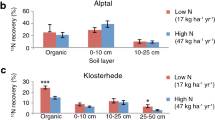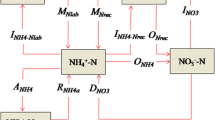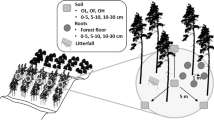Abstract
Conceptual models of nutrient retention in ecosystems suggest that mature forests receiving chronically elevated atmospheric nitrogen (N) deposition should experience increased nitrate (NO3−) losses to streams. However, at the Hubbard Brook Experimental Forest (New Hampshire, USA), recent stream NO3− concentrations have been unexpectedly low in mature watersheds. Poorly understood retention of NO3−-N in soil organic matter (SOM) may explain this discrepancy. The relative availability of C and N in SOM influences NO3−-N retention and may vary during succession due to processes of N mining and re-accumulation. To evaluate the strength of the SOM sink for NO3−-N, we applied a 15NO3− tracer to the mineral soil in eight stands spanning a forest chronosequence from about 20 years to old growth (≫ 200 years). We tracked 15N recovery in SOM fractions in the upper 10 cm of B horizon over 5 weeks. Overall, forest age did not directly control the 5-week recovery of 15N, but it had an indirect effect via its influence on SOM properties such as C/N. Old-growth forest soils had the lowest C/N, implying closer proximity to effective N saturation. Across sites, both the particulate- and mineral-associated SOM fractions rapidly incorporated 15N, but recovery in each fraction generally declined with time, reflecting the dynamic nature of SOM. These results indicate that mineral horizons can provide an important N sink through the short term in forests of all ages, but that SOM-N remains subject to active cycling and potential loss from the soil pool over the longer term.





Similar content being viewed by others
References
Aber JD, Driscoll CT. 1997. Effects of land use, climate variation, and N deposition on N cycling and C storage in northern hardwood forests. Glob Biogeochem Cycles 11:639–48.
Aber JD, Goodale CL, Ollinger SV, Smith M-L, Magill AH, Martin ME, Hallett RA, Stoddard JL. 2003. Is nitrogen deposition altering the nitrogen status of northeastern forests? BioScience 53:375–89.
Aber JD, Ollinger SV, Driscoll CT, Likens GE, Holmes RT, Freuder RJ, Goodale CL. 2002. Inorganic nitrogen losses from a forested ecosystem in response to physical, chemical, biotic, and climatic perturbations. Ecosystems 5:0648–58.
Bailey SW, Brousseau PA, McGuire KJ, Ross DS. 2014. Influence of landscape position and transient water table on soil development and carbon distribution in a steep, headwater catchment. Geoderma 226–227:279–89.
Beare MH, McNeill SJ, Curtin D, Parfitt RL, Jones HS, Dodd MB, Sharp J. 2014. Estimating the organic carbon stabilisation capacity and saturation deficit of soils: a New Zealand case study. Biogeochemistry 120:71–87.
Bernal S, Hedin LO, Likens GE, Gerber S, Buso DC. 2012. Complex response of the forest nitrogen cycle to climate change. PNAS 109:3406–11.
Bingham AH, Cotrufo MF. 2016. Organic nitrogen storage in mineral soil: implications for policy and management. Sci Total Environ 551–552:116–26.
Boström B, Comstedt D, Ekblad A. 2007. Isotope fractionation and 13C enrichment in soil profiles during the decomposition of soil organic matter. Oecologia 153:89–98.
Buurman P, Jongmans AG. 2005. Podzolisation and soil organic matter dynamics. Geoderma 125:71–83.
Castellano MJ, Kaye JP, Lin H, Schmidt JP. 2012. Linking carbon saturation concepts to nitrogen saturation and retention. Ecosystems 15:175–87.
Colman BP, Fierer N, Schimel JP. 2008. Abiotic nitrate incorporation, anaerobic microsites, and the ferrous wheel. Biogeochemistry 91:223–7.
Compton JE, Boone RD. 2002. Soil nitrogen transformations and the role of light fraction organic matter in forest soils. Soil Biol Biochem 34:933–43.
Craine JM, Elmore AJ, Wang L, Augusto L, Baisden WT, Brookshire ENJ, Cramer MD, Hasselquist NJ, Hobbie EA, Kahmen A, Koba K, Kranabetter JM, Mack MC, Marin-Spiotta E, Mayor JR, McLauchlan KK, Michelsen A, Nardoto GB, Oliveira RS, Perakis SS, Peri PL, Quesada CA, Richter A, Schipper LA, Stevenson BA, Turner BL, Viani RAG, Wanek W, Zeller B. 2015. Convergence of soil nitrogen isotopes across global climate gradients. Sci Rep 5:8280.
Curtis CJ, Evans CD, Goodale CL, Heaton THE. 2011. What have stable isotope studies revealed about the nature and mechanisms of N saturation and nitrate leaching from semi-natural catchments? Ecosystems 14:1021–37.
Dail DB, Davidson EA, Chorover J. 2001. Rapid abiotic transformation of nitrate in an acid forest soil. Biogeochemistry 54:131–46.
Davidson EA, Chorover J, Dail DB. 2003. A mechanism of abiotic immobilization of nitrate in forest ecosystems: the ferrous wheel hypothesis. Glob Change Biol 9:228–36.
Dittman JA, Driscoll CT, Groffman PM, Fahey TJ. 2007. Dynamics of nitrogen and dissolved organic carbon at the Hubbard Brook Experimental Forest. Ecology 88:1153–66.
Driscoll CT, Whitall D, Aber J, Boyer E, Castro M, Cronan C, Goodale CL, Groffman P, Hopkinson C, Lambert K, Lawrence G, Ollinger S. 2003. Nitrogen pollution in the northeastern United States: sources, effects, and management options. BioScience 53:357–74.
Eusterhues K, Rumpel C, Kleber M, Kögel-Knabner I. 2003. Stabilisation of soil organic matter by interactions with minerals as revealed by mineral dissolution and oxidative degradation. Org Geochem 34:1591–600.
Evans CD, Caporn SJM, Carroll JA, Pilkington MG, Wilson DB, Ray N, Cresswell N. 2006. Modelling nitrogen saturation and carbon accumulation in heathland soils under elevated nitrogen deposition. Environ Pollut 143:468–78.
Fahey TJ, Hughes JW, Pu M, Arthur MA. 1988. Root decomposition and nutrient flux following whole-tree harvest of northern hardwood forest. For Sci USA. http://agris.fao.org/agris-search/search.do?recordID=US8860983. Last accessed 08/02/2018.
Fahey TJ, Siccama TG, Driscoll CT, Likens GE, Campbell J, Johnson CE, Battles JJ, Aber JD, Cole JJ, Fisk MC, Groffman PM, Hamburg SP, Holmes RT, Schwarz PA, Yanai RD. 2005. The biogeochemistry of carbon at Hubbard Brook. Biogeochemistry 75:109–76.
Fahey TJ, Yavitt JB, Sherman RE, Groffman PM, Fisk MC, Maerz JC. 2011. Transport of carbon and nitrogen between litter and soil organic matter in a northern hardwood forest. Ecosystems 14:326–40.
Fisk MC, Zak DR, Crow TR. 2002. Nitrogen storage and cycling in old- and second-growth northern hardwood forests. Ecology 83:73–87.
Fitzhugh RD, Likens GE, Driscoll CT, Mitchell MJ, Groffman PM, Fahey TJ, Hardy JP. 2003. Role of soil freezing events in interannual patterns of stream chemistry at the Hubbard Brook experimental forest, New Hampshire. Environ Sci Technol 37:1575–80.
Fuss CB, Driscoll CT, Campbell JL. 2015. Recovery from chronic and snowmelt acidification: long-term trends in stream and soil water chemistry at the Hubbard Brook Experimental Forest, New Hampshire, USA. J Geophys Res Biogeosci 120:2360–74.
Galloway JN, Townsend AR, Erisman JW, Bekunda M, Cai Z, Freney JR, Martinelli LA, Seitzinger SP, Sutton MA. 2008. Transformation of the nitrogen cycle: recent trends, questions, and potential solutions. Science 320:889–92.
Gbondo-Tugbawa SS, Driscoll CT. 2002. Retrospective analysis of the response of soil and stream chemistry of a northern forest ecosystem to atmospheric emission controls from the 1970 and 1990 amendments of the Clean Air Act. Environ Sci Technol 36:4714–20.
Goodale CL. 2017. Multiyear fate of a 15N tracer in a mixed deciduous forest: retention, redistribution, and differences by mycorrhizal association. Glob Change Biol 23:867–80.
Goodale CL, Aber JD, McDowell WH. 2000. The long-term effects of disturbance on organic and inorganic nitrogen export in the white mountains, New Hampshire. Ecosystems 3:433–50.
Goodale CL, Aber JD, Vitousek PM. 2003. An unexpected nitrate decline in New Hampshire streams. Ecosystems 6:0075–86.
Goodale CL, Fredriksen G, Weiss MS, McCalley CK, Sparks JP, Thomas SA. 2015. Soil processes drive seasonal variation in retention of 15N tracers in a deciduous forest catchment. Ecology 96:2653–68.
Gorham E, Vitousek PM, Reiners WA. 1979. The regulation of chemical budgets over the course of terrestrial ecosystem succession. Annu Rev Ecol Syst 10:53–84.
Groffman PM, Driscoll CT, Durán J, Campbell JL, Christenson LM, Fahey TJ, Fisk MC, Fuss C, Likens GE, Lovett G, Rustad L, Templer PH. 2018. Nitrogen oligotrophication in northern hardwood forests. Biogeochemistry 141:523–39.
Hagedorn F, Maurer S, Bucher JB, Siegwolf RTW. 2005. Immobilization, stabilization and remobilization of nitrogen in forest soils at elevated CO2: a 15N and 13C tracer study. Glob Change Biol 11:1816–27.
Hart SC, Firestone MK. 1991. Forest floor-mineral soil interactions in the internal nitrogen cycle of an old-growth forest. Biogeochemistry 12:103–27.
Hassink J. 1997. The capacity of soils to preserve organic C and N by their association with clay and silt particles. Plant Soil 191:77–87.
Högberg P. 1997. Tansley Review No. 95 15N natural abundance in soil–plant systems. New Phytol 137:179–203.
Holmes WE, Zak DR. 1994. Soil microbial biomass dynamics and net nitrogen mineralization in northern hardwood ecosystems. Soil Sci Soc Am J 58:238–43.
Holub SM, Lajtha K. 2004. The fate and retention of organic and inorganic 15N-nitrogen in an old-growth forest soil in Western Oregon. Ecosystems 7:368–80.
Huntington TG, Ryan DF, Hamburg SP. 1988. Estimating soil nitrogen and carbon pools in a northern hardwood forest ecosystem. Soil Sci Soc Am J 52:1162.
Jastrow JD, Miller RM, Boutton TW. 1996. Carbon dynamics of aggregate-associated organic matter estimated by carbon-13 natural abundance. Soil Sci Soc Am J 60:801–7.
Johnson CE, Johnson AH, Huntington TG, Siccama TG. 1991. Whole-tree clear-cutting effects on soil horizons and organic-matter pools. Soil Sci Soc Am J 55:497–502.
Kaiser K, Kalbitz K. 2012. Cycling downwards—dissolved organic matter in soils. Soil Biol Biochem 52:29–32.
Kalbitz K, Schwesig D, Schmerwitz J, Kaiser K, Haumaier L, Glaser B, Ellerbrock R, Leinweber P. 2003. Changes in properties of soil-derived dissolved organic matter induced by biodegradation. Soil Biol Biochem 35:1129–42.
Kaye JP, Binkley D, Rhoades C. 2003. Stable soil nitrogen accumulation and flexible organic matter stoichiometry during primary floodplain succession. Biogeochemistry 63:1–22.
Keiluweit M, Nico PS, Kleber M, Fendorf S. 2016. Are oxygen limitations under recognized regulators of organic carbon turnover in upland soils? Biogeochemistry 127:157–71.
Kleber M, Mikutta R, Torn MS, Jahn R. 2005. Poorly crystalline mineral phases protect organic matter in acid subsoil horizons. Eur J Soil Sci 56:717–25.
Kleber M, Sollins P, Sutton R. 2007. A conceptual model of organo-mineral interactions in soils: self-assembly of organic molecular fragments into zonal structures on mineral surfaces. Biogeochemistry 85:9–24.
Kopáček J, Cosby BJ, Evans CD, Hruška J, Moldan F, Oulehle F, Šantrůčková H, Tahovská K, Wright RF. 2013. Nitrogen, organic carbon and sulphur cycling in terrestrial ecosystems: linking nitrogen saturation to carbon limitation of soil microbial processes. Biogeochemistry 115:33–51.
Kramer MG, Lajtha K, Aufdenkampe AK. 2017. Depth trends of soil organic matter C: N and 15N natural abundance controlled by association with minerals. Biogeochemistry 136:237–48.
Kuzyakov Y, Xu X. 2013. Competition between roots and microorganisms for nitrogen: mechanisms and ecological relevance. New Phytol 198:656–69.
Lamontagne S, Schiff SL, Elgood RJ. 2000. Recovery of 15N-labelled nitrate applied to a small upland boreal forest catchment. Can J For Res 30:1165–77.
LeBauer DS, Treseder KK. 2008. Nitrogen limitation of net primary productivity in terrestrial ecosystems is globally distributed. Ecology 89:371–9.
Lehmann J, Kleber M. 2015. The contentious nature of soil organic matter. Nature 528:60–8.
Lewis DB, Castellano MJ, Kaye JP. 2014. Forest succession, soil carbon accumulation, and rapid nitrogen storage in poorly remineralized soil organic matter. Ecology 95:2687–93.
Likens GE. 2013. Biogeochemistry of a forested ecosystem. New York: Springer.
Lovett GM, Goodale CL. 2011. A new conceptual model of nitrogen saturation based on experimental nitrogen addition to an oak forest. Ecosystems 14:615–31.
Lovett GM, Goodale CL, Ollinger SV, Fuss CB, Ouimette AP, Likens GE. 2018. Nutrient retention during ecosystem succession: a revised conceptual model. Front Ecol Environ 16:532–8.
Morier I, Schleppi P, Saurer M, Providoli I, Guenat C. 2010. Retention and hydrolysable fraction of atmospherically deposited nitrogen in two contrasting forest soils in Switzerland. Eur J Soil Sci 61:197–206.
Nadelhoffer KJ, Colman BP, Currie WS, Magill A, Aber JD. 2004. Decadal-scale fates of 15N tracers added to oak and pine stands under ambient and elevated N inputs at the Harvard Forest (USA). For Ecol Manag 196:89–107.
Nadelhoffer KJ, Fry B. 1988. Controls on natural nitrogen-15 and carbon-13 abundances in forest soil organic matter. Soil Sci Soc Am J 52:1633–40.
Pan Y, Chen JM, Birdsey R, McCullough K, He L, Deng F. 2011. Age structure and disturbance legacy of North American forests. Biogeosciences 8:715–32.
Perakis SS, Hedin LO. 2001. Fluxes and fates of nitrogen in soil of an unpolluted old-growth temperate forest, Southern Chile. Ecology 82:2245–60.
Perakis SS, Hedin LO. 2002. Nitrogen loss from unpolluted South American forests mainly via dissolved organic compounds. Nature 415:416–19.
Pourmokhtarian A, Driscoll CT, Campbell JL, Hayhoe K. 2012. Modeling potential hydrochemical responses to climate change and increasing CO2 at the Hubbard Brook Experimental Forest using a dynamic biogeochemical model (PnET-BGC). Water Resour Res 48:W07514.
Pries CEH, Bird JA, Castanha C, Hatton P-J, Torn MS. 2017. Long term decomposition: the influence of litter type and soil horizon on retention of plant carbon and nitrogen in soils. Biogeochemistry 134:5–16.
Richter DD, Markewitz D, Heine PR, Jin V, Raikes J, Tian K, Wells CG. 2000. Legacies of agriculture and forest regrowth in the nitrogen of old-field soils. For Ecol Manag 138:233–48.
Riha SJ, Campbell GS, Wolfe J. 1986. A model of competition for ammonium among heterotrophs, nitrifiers, and roots 1. Soil Sci Soc Am J 50:1463–6.
Rumpel C, Kögel-Knabner I. 2011. Deep soil organic matter—a key but poorly understood component of terrestrial C cycle. Plant Soil 338:143–58.
Schmidt BHM, Matzner E. 2009. Abiotic reaction of nitrite with dissolved organic carbon? Testing the ferrous wheel hypothesis. Biogeochemistry 93:291–6.
Schrumpf M, Kaiser K, Guggenberger G, Persson T, Kögel-Knabner I, Schulze E-D. 2013. Storage and stability of organic carbon in soils as related to depth, occlusion within aggregates, and attachment to minerals. Biogeosciences 10:1675–91.
Scott EE, Rothstein DE. 2014. The dynamic exchange of dissolved organic matter percolating through six diverse soils. Soil Biol Biochem 69:83–92.
Seely B, Lajtha K. 1997. Application of a 15N tracer to simulate and track the fate of atmospherically deposited N in the coastal forests of the Waquoit Bay Watershed, Cape Cod, Massachusetts. Oecologia 112:393–402.
Six J, Conant RT, Paul EA, Paustian K. 2002. Stabilization mechanisms of soil organic matter: implications for C-saturation of soils. Plant Soil 241:155–76.
Sollins P, Swanston C, Kleber M, Filley T, Kramer M, Crow S, Caldwell BA, Lajtha K, Bowden R. 2006. Organic C and N stabilization in a forest soil: evidence from sequential density fractionation. Soil Biol Biochem 38:3313–24.
Stark JM, Hart SC. 1997. High rates of nitrification and nitrate turnover in undisturbed coniferous forests. Nature 385:61.
Swanston CW, Torn MS, Hanson PJ, Southon JR, Garten CT, Hanlon EM, Ganio L. 2005. Initial characterization of processes of soil carbon stabilization using forest stand-level radiocarbon enrichment. Geoderma 128:52–62.
Tahovská K, Kaňa J, Bárta J, Oulehle F, Richter A, Šantrůčková H. 2013. Microbial N immobilization is of great importance in acidified mountain spruce forest soils. Soil Biol Biochem 59:58–71.
Tang J, Bolstad PV, Martin JG. 2009. Soil carbon fluxes and stocks in a Great Lakes forest chronosequence. Glob Change Biol 15:145–55.
Templer PH, Lovett GM, Weathers KC, Findlay SE, Dawson TE. 2005. Influence of tree species on forest nitrogen retention in the Catskill Mountains, New York, USA. Ecosystems 8:1–16.
Templer PH, Mack MC, Iii FSC, Christenson LM, Compton JE, Crook HD, Currie WS, Curtis CJ, Dail DB, D’Antonio CM, Emmett BA, Epstein HE, Goodale CL, Gundersen P, Hobbie SE, Holland K, Hooper DU, Hungate BA, Lamontagne S, Nadelhoffer KJ, Osenberg CW, Perakis SS, Schleppi P, Schimel J, Schmidt IK, Sommerkorn M, Spoelstra J, Tietema A, Wessel WW, Zak DR. 2012. Sinks for nitrogen inputs in terrestrial ecosystems: a meta-analysis of 15N tracer field studies. Ecology 93:1816–29.
Vitousek PM, Reiners WA. 1975. Ecosystem succession and nutrient retention: a hypothesis. BioScience 25:376–81.
Vogel C, Mueller CW, Höschen C, Buegger F, Heister K, Schulz S, Schloter M, Kögel-Knabner I. 2014. Submicron structures provide preferential spots for carbon and nitrogen sequestration in soils. Nat Commun 5:2947.
von Lützow M, Kögel-Knabner I, Ekschmitt K, Matzner E, Guggenberger G, Marschner B, Flessa H. 2006. Stabilization of organic matter in temperate soils: mechanisms and their relevance under different soil conditions—a review. Eur J Soil Sci 57:426–45.
Wagai R, Kajiura M, Asano M, Hiradate S. 2015. Nature of soil organo-mineral assemblage examined by sequential density fractionation with and without sonication: is allophanic soil different? Geoderma 241–242:295–305.
Weitzman JN, Kaye JP. 2016. Variability in soil nitrogen retention across forest, urban, and agricultural land uses. Ecosystems 19:1345–61.
Yanai RD, Arthur MA, Siccama TG, Federer CA. 2000. Challenges of measuring forest floor organic matter dynamics: repeated measures from a chronosequence. For Ecol Manag 138:273–83.
Yanai RD, Vadeboncoeur MA, Hamburg SP, Arthur MA, Fuss CB, Groffman PM, Siccama TG, Driscoll CT. 2013. From missing source to missing sink: long-term changes in the nitrogen budget of a northern hardwood forest. Environ Sci Technol 47:11440–8.
Zogg GP, Zak DR, Pregitzer KS, Burton AJ. 2000. Microbial immobilization and the retention of anthropogenic nitrate in a northern hardwood forest. Ecology 81:1858–66.
Acknowledgements
We thank Nick Jakubek, Wade Simmons, Liza Tetley, Charlene Tarsa, and Mikayla Jacobs for assistance with field or laboratory work. We also thank two reviewers that provided helpful comments to improve the manuscript. The HBEF is administered by the US Department of Agriculture Forest Service, Northern Forest Research Station, Newtown Square, PA. Hubbard Brook is a National Science Foundation supported Long-Term Ecological Research site. Support for this project was provided by the National Science Foundation (DEB 1257956—Ecosystem Studies; and DEB 1633026 and DEB 1637685—Long-Term Ecological Research).
Author information
Authors and Affiliations
Corresponding author
Additional information
Author Contributions
Conceived of or designed study: CBF, GML, CLG, SVO, AKL, APO. Performed research: CBF, GML, AKL. Analyzed data: CBF, APO. Wrote the paper: CBF, GML, CLG, SVO, AKL, APO.
Electronic supplementary material
Below is the link to the electronic supplementary material.
Rights and permissions
About this article
Cite this article
Fuss, C.B., Lovett, G.M., Goodale, C.L. et al. Retention of Nitrate-N in Mineral Soil Organic Matter in Different Forest Age Classes. Ecosystems 22, 1280–1294 (2019). https://doi.org/10.1007/s10021-018-0328-z
Received:
Accepted:
Published:
Issue Date:
DOI: https://doi.org/10.1007/s10021-018-0328-z




